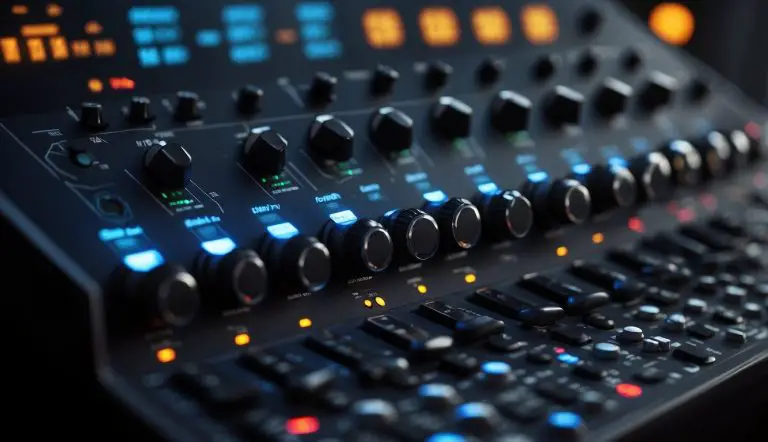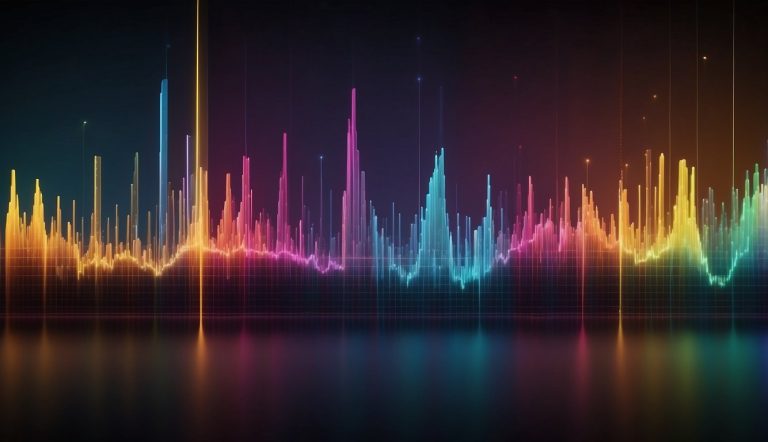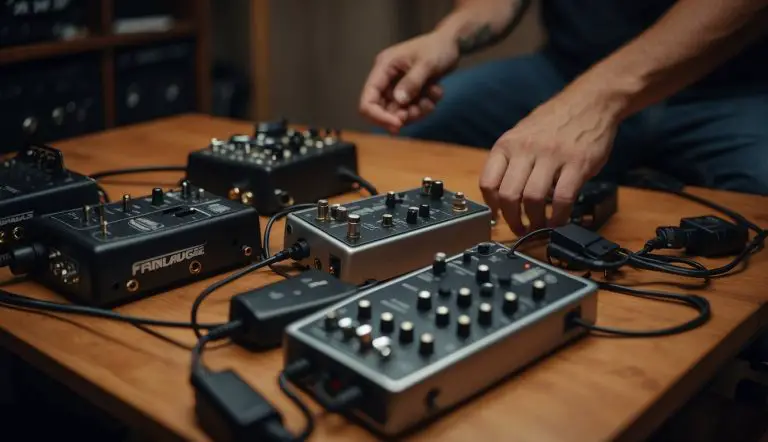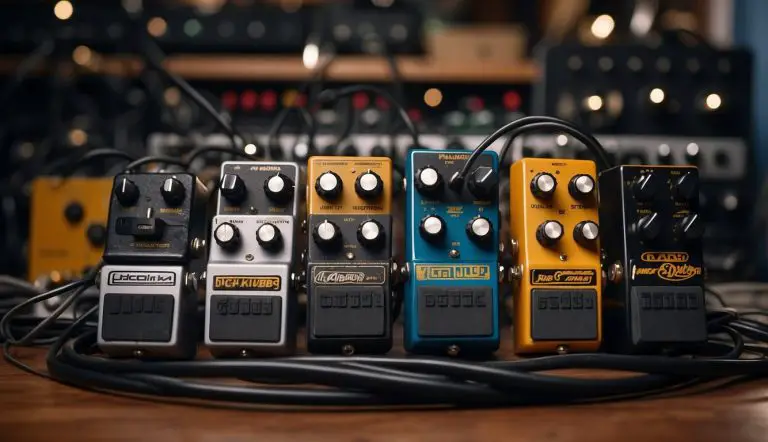9 Best Amp for Pedals and Guitar Effects
In this article, we will talk about amps that best serve as pedal platforms. Such amplifiers are perfect for guitarists who need the most distortion of their pedals.
When you’re interested in having several different sounds inside your package, it might be hard to distort the amplification when you don’t want it.
If you run delays and reverbs in front of your amp as I do, you need something with enough headroom to prevent your spacious sounds from becoming unrecognizable mush.
The right amp for pedals has a good neutral clean sound, lots of additional headroom, and simple ease of controls without many additional features.
Now let’s look at those best pedalboard-friendly amplifiers.
Table of Contents
9 Best Guitar Amps for Pedalboards
Vox AC30 Amplifiers
The Vox AC30 is the fundamental sound of rock’n roll history.
The AC30C2 is fitted with 30 watts of power and 2×12″greenback or Alnico Blue speakers (the CX2 is fitted with Alnico speakers).
I love tremolo and spring reverb on those amplifiers and that with a footswitch you can switch them on and off. This footswitch press provides you with access to additional rooty rock ‘ n ‘ roll tones.
The AC30 circuit is second to none when it is washed up and only single-coil guitars can have this power without the help of a triple leak.
The AC30 provides an excess of average, though, so you have to carefully pick your pedals. Tube Screamer styles appear to add even more than is actually there-as you drive the amps forward, a flatter boost is always a stronger buddy.
Put clear, the Top Boost channel gives you everything you need, its strong bass, and a defined treble. The sound of so many popular songs, from Tom Petty to George Harrison.
A bypass-controlled effects loop on the C2 allows users to apply time-based effects when running the amp dirty – a contemporary convenience not present on the original 60s – and the tramp-controlled tremolo and reverb allow you to reach more rootsy rock ‘n’ rolls.F
This amplifier is a perfect choice for those who gravitate to a lighter but yet more full amplifier. Read Vox AC30 review here.
Marshall MG102CFx MG
Marshall amplifiers have gained an enviable reputation amongst musicians over the years, and this 100W MG102CFX MG amp continues to bear its name.
This is a very powerful tool that promises years of consistent support. Marshall amps are made to last.
The no-nonsense style is especially perfect for beginners. Too many manufacturers feel obligated to cram the front panel with a large array of dials and buttons, most of which have little to do with beginners.
The MP3 entry is an outstanding option. You can connect to your screen, phone, or other gadget and play music directly from the speaker.
Playing with your favorite track will easily create confidence and inspire you to work.
MG102CFX also has a switchable filter loop to incorporate a desired external sound filter. This configuration also features a regular 2-button foot turn.
Fender Hot Rod Deville and Hot Rod Deluxe Amplifiers
The Deville 60 Watt Fender and the identical but cheaper 40 Watt Hot Rod Deluxe are two of the most popular pedal hobbies.
Most pedal makers also use a Hot Rod Deluxe amp in their labs to test pedals. Such amps are very familiar to me with the Hot Rod Deville with its 4 to 10 cabinet on the slight bottom.
The Devil has a song of headroom and gets really loud, and I would go to the Hot Rod Deluxe if you wanted the good tube to split up with less noise.
These two amps have a fantastic bottom and the classic clear sound and reverb of Fender. If you want a colder voice, the # 2 low-income feedback for these bad guys is a murderer.
Such amplifiers have relatively basic controls and a very lacking drive tube. You should easily avoid the rough driving canal if you hold to your feet, and these babies can sing!
Plus it is impossible to beat the affordable price on these amplifiers and you will find them at any location/house set-up worldwide.
Peavey Bandit 112 TransTube
The Peavey Bandit 112 Trans Tube is a beautiful device that uses Peavey’s Trans Tube technology, allowing the amplifier to produce tube-like tones from a fully non-tube framework.
Although this is may not be the most versatile speaker, it focuses on what matters – amplifying the aspect of your play without coloring the generated sounds.
This is also an ideal amplifier for someone who plays so several pedals. Since this amplifier is a strong state tool, the music generated is surprisingly fine, even if the volume is to be reduced.
There are two channels, one of which is a clean channel and the other a lead channel. That channel has a three-position switch which allows for a tone range that simulates various amp types.
The amp also has reverb and a volume switch for the listener.
The Peavey Bandit 112 delivers a maximum range of 80 watts power through a 12-inch Blue Marvel speaker while an additional speaker socket can be attached, if needed, to a bigger car.
Two foot-switchable channels with separate EQ, TDynamics, intensity, and echo sensors, as well as reverb and a foot-switchable effect loop, are incredibly useful in any concert.
When the inner effects on this amplifier are switched off, it can be used with pedals as an excellent amp. You can really get the most out of your pedal bank and simply reinforce whatever strange sounds you want to make!
Could be used as a clear amp for modern or vintage channel voicing or you could just generate a high gain, classic or vintage voicing on either the lead channel in order to provide massive quantities of instantaneous tonal variety.
The design efficiency of this amplifier is second to none. We sometimes do not test Peavey speakers, but when we do, we are often happily shocked.
We may not have the prestige of some of the “premium” manufacturers, but we know how to create amps which last.
Fender ’68 Custom Deluxe Reverb Amplifier
As a pedal base, the Deluxe Reverb ’68 seems to be almost perfect. It has these familiar clean Fender tones with added plenitude and low finish.
It certainly sounds darker compare to the ’65 and adds plenty of punch.
It comes with large spring reverb, a tremolo-like retro sound, and a 12 “stock Celestion G12V-70 speaker.
A major change to this amplifier was the Bassman Custom Channel Tone Line.
This channel became my choice for pedals because it had a big headroom as well as a low end.
DR. Z M12 Amplifier
The M12 is Dr. Z is specifically built for pedal fanatics. Using an EF86 preamp, it fits superbly well with fuzz, distortion, overdrive, and boost.
You may also use it as a head and connect it with your preferred speaker cabinet in 1×10, 2×10 or 1×12 hybrid configurations. This amplifier features the same tonal stack that Dr. Z Route 66 likes but with 12 watts of power.
It can provide its own organic grinding, which can be accomplished with the change of the input switch to High and volume cranking.
The settings on this amp are very basic with Power, Treble and Bass buttons, and Hi and Low response switches.
It has two El86 output tubes that completely smooth out pedals, even at a lighter stage, the M12 never gets rough.
Speaker choices include a greenback of 12 inches or a Z10 of 10 inches.
There is always a lot of headroom to guarantee that you get the most from the pedals.
If you use a microphone for your amplifier, you really had no problem in filling the biggest rooms with this one.
Easy and sweet, for both pedals and EL84 fans, it is an excellent pick.
Fender Super Champ X2
This amp ‘s spirit is total Fender. It is based on approximately 15W of rich double-channel amps providing quality on the same level as much bigger and more powerful guitar amplifiers.
The classic Fender sound is well presented here, and you will soon learn why the company is such a favorite for guitarists when you play through this amplifier!
This amplifier is ideal for the training room or for gigging. Go no further than the Fender Super Champ X2 if you are simply looking for a portable speaker with all the latest technology, including a large variety of built-in visual effects.
Using this amplifier you can create limitless tones that can allow you to perfect your own signature sound. This speaker is especially appropriate for beginners as it
The construction standard is amazing. Fender has a good reputation for creating amplifiers which can take several years. That is no exception.
The people we talked to for the review reported that they could still take advantage of beating vintage Super Champ versions when they met one in practice rooms or behind the scenes.
USB production is genuinely groundbreaking. With this performance, it is possible to record the new riff directly on your machine.
The voice controls are very simple to use and have access to 16 different amplifier styles – Tweed, Blackface, Blues, and Rock, for a few.
If you play enormous venues, you’ll need more control. If, though, you ‘re looking for a lightweight and powerful Super Champ X2 amplifier that is ideal for your pedal console.
Marshall Astoria Classic Amplifier
The myth of Marshall amps is not questioned. However, these amps are generally referred to as anything but neutral pedalboards.
When you think of Marshall, you usually think that you are seriously distorted with a difficult crunch.
With Astoria Marshall, a significant part of the pedal enthusiasts demand is covered, by giving the pedal user a high-quality amp.
A 1/12 hybrid with a Creamback speaker that offers you a lot of power and clarity is a British modern classic.
This amp has a large headroom and stays pretty clean when it is very busy.
It provides both standards and sensitivity as well as edge settings, which are very helpful once dialing this amplifier through.
This amplifier had almost to be knocked down of our list merely because of the high price but it still provides good sound and performance
It is a stunning amplifier that in many ways brings one back to Jim Marshall’s initial concept while he was making amps for Jimi Hendrix and Jimmy Page.
The Marshall Astoria is a dream if you can afford it.
Two-Rock Studio Pro 35
The studio line from this popular shop group strives to use the tweakable single channel amp design in a variety of situations, from the business-friendly Business Pro 22 loaded with 6V6 to Studio Pro 50.
However, it is the marvelously functional Studio Pro 35, which we will look in-depth at.
It is an odd amp as there are a number of controls on the rear side, which are really more integral to the tone forming process than being ‘fixed and forgettable.’
The impact loop return basically serves as the principal volume and can be mixed to produce various types of dirt as a function of the gain or master volume controls (both of the front panel).
On the back, there is also a pickup load control to form the front end to match your preferred pick up so you can offset a Tele for an SG when switching.
This is not something we would not notice if it were not used on the amplifier, and only when it is plugged in with no pedal specifically reveals the maximum output.
It is really easy to turn into such Two-Rock Mayer-esque cleans … and the amp can be powered from there into an SRV area with little effort.
More valuable is the contour monitor on the front screen, which provides an aggressive broadband wave.
Anything like that is useful to be compatible with different speaker cabs and guitars and it can help the customer retain a constant EQ curve from place to place.
More tone formation is possible through push-pull switches on the tone stack. There is a high-end boost close to the bright turn on an aged Fender – that slowly gets worse as the gain is increased.
The bass control system is lower mid / bass for the thickening of a single spiral, with a dumb tone stack that bypasses the mid control to efficiently raise the volume of the contents and the high intermediate range.
There’s ample headroom for small and medium-size displays, especially when combined with a powerful speaker with clean settings, with the 6L6 output tubes pair.
Obviously, you’re usually mic’d and performed via a front-of-house PA on broad stages, so the Studio 35 is perfect in every scenario.
Luckily, with this amp, it’s also very hard to make an overdrive sound poor.
Two-Rock amps are costly for sure, but if you love their “thickened Blackface” flavor, then the entrance price buys a perfect amp and one that takes care of you from the first time you touch the strings.
FAQs
Will I need a huge amplifier to produce a good sound?
Yes, to a point, the days when 3 Marshall stacks are taken to a gig are over unless you’re J Mascis.
Most venues have a good PA network nowadays and microphone your amp to get the most sound.
But size is not nearly as significant as it used to.
Earlier in the day, much of the guitar sound came on stage from speakers when PA systems were sounding pretty terrible.
Nevertheless, others suggest that a larger amplifier and bigger speaker bring you a more powerful sound with a more established low end.
And you wouldn’t want to go too low if this that, dense bottom end is part of your voice.
But I still contend that you wouldn’t need a half pile. A bigger tube combination amp will do what you like.
Will I need an amp tube?
It’s a topic that’s heavily debated and it just depends on what you choose.
Many guitarists will agree that when a solid amp begins to break down and get distorted, they do not get the same smoothness as a tube amp.
That’s why I suggesting tube amps. Everything just comes down to personal taste, consider tube amplifiers and check out some solid-state amps just to see what you want.
In my experience, working through various equipment at training sessions and shows proved to me that in the quest for a sound, you may find that you have something different than you initially desired.
Pedalboard platform amplification is a perfect way to play live. I strongly encourage you to try out these amps for your pedalboard platform building.
So, wwhich amplifier are you using on your pedalboard?
Which is the best amp for pedals in your opinion?
Were you dreaming about a perfect amplifier for your perfect pedal configuration?
Let’s discuss in comment!




